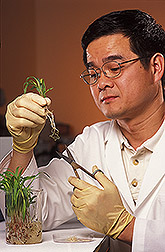It's been many years since I had to live with a dial-up internet connection on a day-to-day basis. It was a miracle then, but now it's just one more story that my kids don't want to hear.
I now take my high speed internet service for granted, except when I pay the bill. And, I don't even need that service when I check my email or surf the web on my handy, dandy smart phone (yet, another bill to pay). I just hop on the 3G trail.
But, recently I had to put together a family reunion in a very, very rural piney woods part of Louisiana.
When I announced that all communication would be via email, I was surprised to learn that some of my relatives still suffer from "sorry, i only have dial-up" illness. It's so much trouble to connect and then wait, that they don't check email often enough to even have the account. And, yes, some of them feel like it's "too much trouble" to even own a computer. My solution: I wrote the email, printed it out and then visited the U.S. post office. Ah, the miracle of reliable delivery really does still exist.
Let me also explain that electricity didn't come to this particular spot in Louisiana until 1953, when my grandmother went door to door signing people up. The story is she used part of her "egg money" to pay whatever it took to get that service down her road. Her indoor plumbing came along just before John Kennedy took office in 1960. And, I'm not sure she ever got a telephone.
So, you can see why I was excited to learn that a part of the American Recovery and Reinvestment Act (Recovery Act) might actually help out my relatives as well as thousands of other folks. Coincidentally, the projects are expected to create about 5,000 immediate and direct jobs
Over $1 billion in loans and grants has been awarded for 68 broadband projects in 31 states and one territory in the first of two scheduled funding rounds from the Recovery Act. That sounds like a cure for a lot of "dial-up."
According to a USDA press release, three types of projects received awards:
- Last-mile remote projects, which will provide broadband service to households and other users in rural areas located at least 50 miles from the nearest non-rural area.
- Last-mile non-remote projects, which will provide broadband service to households and other users located less than 50 miles from the nearest non-rural area.
- Middle-mile projects, which will provide necessary "backbone" services such as interoffice transport, backhaul, Internet connectivity, or special access to rural areas.
The projects will bring broadband service to an estimated 529,249 households, 92,754 businesses and 3,332 anchor institutions across more than 172,000 square miles – a geographic area approximately the size of the state of California. These projects will also provide services to 19 Tribal lands. A second round of successful applicants will be announced later in the 2010 fiscal year.
And, to add to my excitement, I found in
Connecting Rural America that Louisiana was included in the grants, among such other states as: Alabama, Georgia, Mississippi, Virginia, Texas, West Virginia, Tennessee and Missouri.
I'm counting on broadband delivery for the next family reunion invite.
Thanks for reading.
Debra Ferguson










